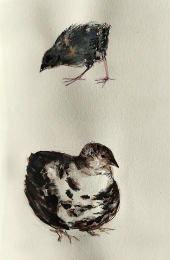Here in the low Sonoran Desert of Arizona, USA, traditionally the first food foraged enmasse for the year, from what I have read, are the buds of the cholla cactus. Anyone who is familiar with cholla cactus is most likely familiar with the teddy bear or jumping cholla varieties. The general rule is not to come within 10 feet of them less they spring to life and start tossing spiney clumps at you. However, there are many varieties of cholla, some of which are highly prized for their flower buds, which are harvested right before they open. The main varieties of cholla harvested from are the buckhorn cholla, staghorn cholla, and I've also heard of using pencil cholla however I have not tried these. The types of cholla listed are not nearly as spiney and with a pair of tongs you can easily access the buds and twist them off.
One things to be careful of is that the native stingless bees like to sleep in the flowers at night! As the flowers will close up once the sun goes down, it makes for a cozy little bed for a bee. So if you are harvesting at night and after the flowers have opened, beware! Although they don't sting, they are a critical part of our naural environment, and the main reason I grow cholla at my home.
Last year I learned to collect cholla buds from Brad Lancaster in his Dunbar Springs neighborhood. We went home with three cuttings which are doing great, but you have to be careful to make sure and keep them oriented in the same direction or else they can get sun scald. They build up a thicker layer on the side most exposed to the sun (south). He also taught us how to make a wonderful salsa with cholla buds, wolfberries (goji berri variety), cilantro and jalapeno. This year I am sharing this recipe with as many people as possible! I'm actually about to go collect some more buds right now because I dried my first two batches and already ate more than half of them. When they are fresh, they are similar to nopal. Mucilingous, a bit tart or sour, and people also describe them like artichoke I believe. Once they are dried, they taste very floral and almost fruity, like a freeze dried strawberry but with much less sugar.
In conclusion, cholla buds are amazing! They are my new favorite foragable in the Sonoran Desert. My goal is to collect enough to last me the year, but that is probably near impossible. Check out my blog post on the subject!
https://fracti-cacti.com/2024/04/18/06-sonoran-foraging-cholla-buds/






